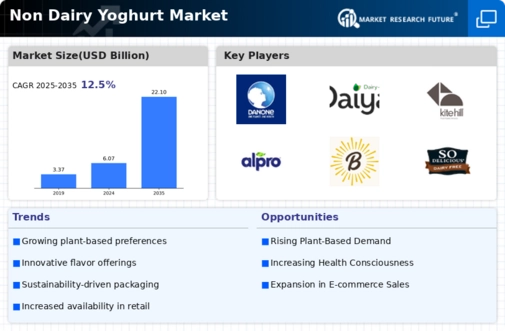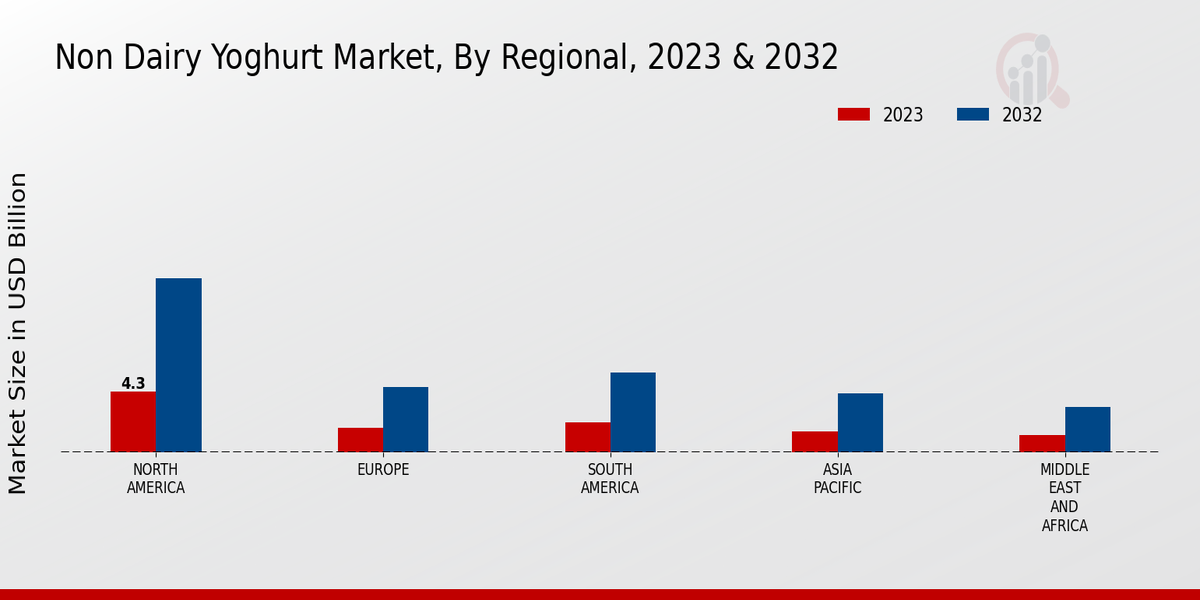Diverse Flavor Profiles
The Global Non Dairy Yoghurt Market Industry benefits from the introduction of diverse flavor profiles that cater to a wide range of consumer preferences. Manufacturers are increasingly innovating to create unique and appealing flavors, such as coconut, almond, and berry blends, which enhance the overall consumer experience. This variety not only attracts new customers but also encourages repeat purchases among existing consumers. The expansion of flavor options is likely to contribute to the market's growth, as it aligns with the evolving tastes of health-conscious individuals. As a result, the industry is poised for substantial growth, potentially reaching 22.1 USD Billion by 2035.
Market Growth Projections
The Global Non Dairy Yoghurt Market Industry is poised for remarkable growth, with projections indicating a substantial increase in market value over the next decade. The market is expected to reach 6.07 USD Billion in 2024 and is forecasted to expand to 22.1 USD Billion by 2035. This growth trajectory suggests a robust compound annual growth rate (CAGR) of 12.47% from 2025 to 2035. Such projections reflect the increasing consumer demand for non-dairy alternatives and the industry's ability to innovate and adapt to changing market dynamics. As the market evolves, it is likely to attract new entrants and foster competition, further enhancing its growth potential.
Rising Health Consciousness
The Global Non Dairy Yoghurt Market Industry experiences a notable surge in demand driven by increasing health consciousness among consumers. As individuals become more aware of the benefits of plant-based diets, the preference for non-dairy alternatives rises. This shift is particularly evident among lactose-intolerant populations and those seeking to reduce animal product consumption. The market's value is projected to reach 6.07 USD Billion in 2024, reflecting a growing inclination towards healthier dietary choices. Furthermore, the trend towards veganism and plant-based diets is likely to propel the market further, as consumers actively seek nutritious and low-calorie options.
Health Benefits of Probiotics
The Global Non Dairy Yoghurt Market Industry is significantly influenced by the growing awareness of the health benefits associated with probiotics. Non-dairy yoghurts are often fortified with probiotics, which are known to promote gut health and enhance overall well-being. As consumers increasingly seek functional foods that offer health advantages, the demand for probiotic-rich non-dairy yoghurts is likely to rise. This trend aligns with the broader movement towards health and wellness, positioning non-dairy yoghurts as a desirable option for health-conscious individuals. The potential for growth in this segment may further solidify the industry's standing in the global market.
Sustainable Production Practices
Sustainability plays a pivotal role in shaping the Global Non Dairy Yoghurt Market Industry. Consumers are increasingly inclined towards products that are produced using environmentally friendly practices. This trend is prompting manufacturers to adopt sustainable sourcing of ingredients and eco-friendly packaging solutions. By prioritizing sustainability, brands can differentiate themselves in a competitive market, appealing to environmentally conscious consumers. The emphasis on sustainability is likely to drive market growth, as it resonates with the values of a significant segment of the population. This alignment with consumer values may further enhance the industry's reputation and market share.
Increased Availability in Retail Channels
The Global Non Dairy Yoghurt Market Industry is witnessing increased availability through various retail channels, including supermarkets, health food stores, and online platforms. This expansion in distribution channels enhances accessibility for consumers, making it easier to find and purchase non-dairy yoghurt products. The rise of e-commerce has particularly transformed the shopping experience, allowing consumers to explore a wider range of options from the comfort of their homes. As the market continues to grow, the increased presence of non-dairy yoghurts in retail settings is likely to contribute to its projected CAGR of 12.47% from 2025 to 2035, indicating a robust future for the industry.


























Leave a Comment